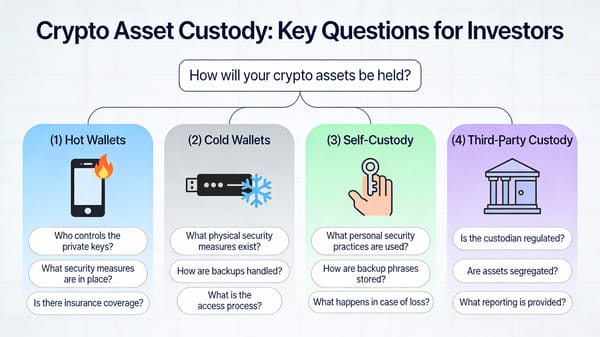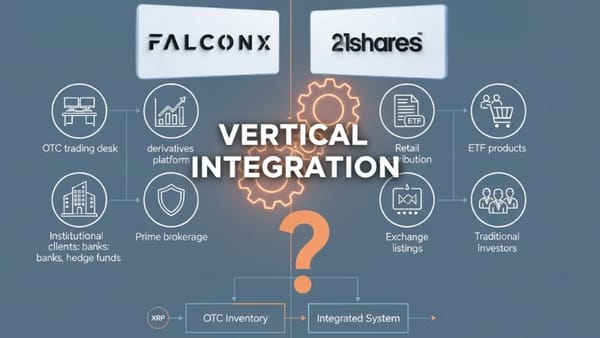Ethereum's $1,000 Gas Fee Crisis: Why Kevin O'Leary Says the World's Largest Blockchain is Breaking Under Real-World Pressure
Ethereum transaction fees hit $1,000 over the weekend, prompting Shark Tank's Kevin O'Leary to warn that the world's largest blockchain "cracks under pressure." What this scalability crisis means for crypto adoption and XRP's competitive position.

Over the weekend, Ethereum experienced a network congestion crisis that sent transaction fees soaring past $1,000 for simple transfers, prompting Shark Tank's Kevin O'Leary to issue a stark warning about the blockchain's scalability limitations. The incident has reignited critical debates about whether current blockchain infrastructure can handle mass adoption.
The Weekend That Exposed Ethereum's Achilles Heel
Kevin O'Leary took to X to highlight what he called a pivotal moment for crypto investors: Ethereum's network became so congested that users faced gas fees exceeding $1,000 just to process small transactions. "That's like paying a thousand-dollar toll to drive on a one-lane highway," O'Leary wrote, emphasizing that the world's largest blockchain "cracks under pressure" when real traffic hits the system.
The congestion event comes at a critical juncture for Ethereum, which has positioned itself as the foundation for decentralized finance (DeFi), non-fungible tokens (NFTs), and enterprise blockchain solutions. According to Etherscan data, average gas prices during peak congestion periods can fluctuate dramatically based on network demand, with priority fees sometimes reaching triple digits in gwei during high-traffic events.
Over the weekend I witnessed something every crypto investor should pay attention to. Ethereum, the largest blockchain in the world, got congested and fees skyrocketed past $1,000 just to process small transactions. That’s like paying a thousand-dollar toll to drive on a one-lane… pic.twitter.com/m9o1sRUQE0
— Kevin O'Leary aka Mr. Wonderful (@kevinolearytv) October 16, 2025
Why Scalability Matters More Than Ever
O'Leary's criticism cuts to the heart of blockchain's infrastructure challenge: "For over a decade we've talked about going on-chain, and now with real-world adoption finally happening, the cracks are showing." His observation points to a fundamental tension in the crypto ecosystem—the gap between theoretical promises and practical performance.
Ethereum has been working on scalability solutions for years. The network's transition to proof-of-stake through The Merge in September 2022 was a significant milestone, but it primarily addressed energy consumption rather than transaction throughput. Layer-2 scaling solutions like Arbitrum, Optimism, and Polygon have emerged to alleviate mainnet congestion, yet O'Leary's comments suggest these measures haven't fully solved the problem during peak demand periods.
The investor's metaphor of a "one-lane highway" resonates because it illustrates a core limitation: Ethereum's base layer can only process approximately 15-30 transactions per second, far below the thousands required for true mainstream adoption. When multiple popular applications or events drive simultaneous activity, the network's auction-based fee market pushes costs to prohibitive levels.
Market Implications Beyond Ethereum
This scalability crisis has broader implications for the cryptocurrency market. While Ethereum dominates with its extensive developer ecosystem and total value locked in DeFi protocols exceeding $50 billion, competing blockchains are positioning themselves as faster, cheaper alternatives. Solana, BNB Chain, and newer entrants like Sui and Aptos have built their value propositions around superior transaction speeds and lower costs.
The timing is particularly significant as institutional adoption accelerates. With the approval of spot Bitcoin ETFs in January 2024 and growing institutional interest in tokenized real-world assets, blockchain networks face unprecedented pressure to demonstrate enterprise-grade reliability and cost-efficiency.
XRP and Ripple: Positioned for Ethereum's Pain Points?
O'Leary's critique of Ethereum's scalability issues indirectly highlights the competitive advantages that XRP and Ripple's technology have long emphasized. The XRP Ledger (XRPL) can process 1,500 transactions per second with settlement times of 3-5 seconds and transaction costs typically under $0.01—a stark contrast to Ethereum's weekend crisis.
Ripple's Strategic Positioning
Ripple has consistently positioned its technology as enterprise-ready infrastructure designed for high-volume, cost-sensitive use cases like cross-border payments. The recent Ethereum congestion validates Ripple's decade-long argument that purpose-built blockchain solutions may outperform general-purpose platforms for specific applications.
Following the partial legal victory against the SEC in July 2023, when Judge Analisa Torres ruled that XRP sales on digital asset exchanges are not securities offerings, Ripple has expanded its institutional partnerships. The company's focus on regulatory clarity and scalable infrastructure becomes more compelling when Ethereum demonstrates capacity limitations during critical moments.
XRP Price Implications
The narrative shift around blockchain scalability could support XRP's valuation in several ways:
- Institutional Migration: If enterprises prioritize cost predictability and transaction reliability, networks like XRPL may capture market share from Ethereum-based solutions
- Payment Corridor Expansion: Ripple's On-Demand Liquidity (ODL) service, which uses XRP for cross-border settlements, benefits from demonstrations of competing networks' fee volatility
- Developer Attention: Ethereum's scaling challenges may drive developers toward alternative platforms, potentially expanding XRPL's ecosystem
However, it's important to note that Ethereum's extensive developer community, existing infrastructure, and ongoing scaling roadmap (including future sharding implementations) represent significant competitive moats. XRP's price performance will ultimately depend on Ripple's ability to convert these technical advantages into measurable business adoption.
Regulatory Advantages
The scalability crisis also intersects with regulatory considerations. As blockchain technology moves toward mainstream finance, regulators increasingly scrutinize network reliability and consumer protection. Ethereum's extreme fee volatility raises questions about accessibility and fairness—issues that could influence future regulatory frameworks.
Ripple's proactive engagement with regulators and focus on compliance-oriented use cases position the company favorably in an environment where infrastructure reliability becomes a regulatory concern. The company's partnerships with central banks exploring central bank digital currencies (CBDCs) demonstrate how purpose-built blockchain solutions align with institutional requirements.
SWIFT's Linea Pivot: A Strategic Response to Ethereum's Limitations?
The timing of Ethereum's gas fee crisis takes on added significance given SWIFT's recent blockchain moves. In September 2025, SWIFT selected Linea, an Ethereum Layer 2 network developed by ConsenSys, for a pilot project testing blockchain-based interbank messaging and settlement. Major banks, including BNP Paribas and BNY Mellon, are participating in this pilot, which could transform how the $7 trillion-per-day SWIFT network operates.
Why Layer 2 Matters for SWIFT
SWIFT explicitly rejected speculation that it might adopt XRP Ledger or Hedera Hashgraph, instead choosing Linea for its zero-knowledge proof technology and Ethereum alignment. The decision reveals SWIFT's strategy: maintain compatibility with Ethereum's massive ecosystem while avoiding the mainnet's scalability problems.
Linea offers transaction fees up to 35 times lower than Ethereum mainnet, with users typically paying pennies in gas fees. The network processes transactions with a stabilized base fee of just 7 wei, compared to Ethereum's volatile fee market. For SWIFT's pilot involving interbank messaging that requires predictable costs and instant settlement, these economics are critical.
The Layer 2 Solution—And Its Dependency Problem
Linea uses zk-rollup technology to process transactions off-chain before submitting cryptographic proofs to Ethereum, enabling thousands of transactions per second while inheriting Ethereum's security. This architecture solves the immediate scalability problem that O'Leary highlighted.
However, here's the critical vulnerability: Layer 2 solutions historically faced high costs because approximately 60% of their transaction expenses came from posting data to Ethereum's mainnet via CALLDATA. When Ethereum mainnet experiences the kind of congestion that drives fees to $1,000, Layer 2 networks still feel the impact through increased data posting costs, even if end users don't directly pay mainnet gas prices.
The Dencun upgrade and EIP-4844 implementation introduced "blobs" for more efficient data storage, significantly reducing L2 costs—but the fundamental dependency on Ethereum's base layer remains. If Ethereum experiences sustained congestion or fee spikes, Layer 2 finality times can increase and operational costs for sequencers rise.
SWIFT's Institutional Requirements vs. Ethereum's Volatility
A source close to the SWIFT pilot called it "a technological transformation for the international payments industry that will take months to develop but carries long-term systemic impact". For a network processing trillions of dollars daily, predictability isn't optional—it's mandatory.
The pilot includes discussions about creating a stablecoin-like settlement token that would transform SWIFT from a messaging service into a value transfer platform. This represents direct competition with Ripple's ODL service, but it is built on an Ethereum-compatible infrastructure.
The weekend's gas fee crisis raises uncomfortable questions: Can Layer 2 solutions provide the reliability global financial infrastructure demands when the underlying Layer 1 periodically experiences extreme congestion? SWIFT chose Linea specifically for its zero-knowledge privacy features, which allow processing transactions while keeping sensitive bank data confidential—a core requirement for interbank communication. But privacy and efficiency mean little if the underlying infrastructure experiences unpredictable stress.
XRP's Competitive Advantage Amplified
This development paradoxically strengthens Ripple's positioning. While SWIFT experiments with Layer 2 solutions that still depend on Ethereum's congestion-prone base layer, XRPL operates as an independent Layer 1 purpose-built for payments. The XRP Ledger doesn't face the architectural complexity or dependency risks that come with Layer 2 rollup technology.
Some analysts note that SWIFT's blockchain pilot could actually threaten Ripple's competitive advantage by offering similar speed and cost benefits through collaboration with trusted banking giants, without requiring institutions to adopt an entirely new network. However, the counterargument is equally compelling: if Ethereum's base layer proves unreliable during stress tests, institutions may prefer XRPL's simpler, more predictable architecture over Layer 2 workarounds.
The Infrastructure Reality Check
O'Leary's blunt assessment—"Innovation isn't just about hype or speculation, it's about building infrastructure that can actually handle scale"—echoes concerns that have long simmered beneath crypto's bullish narratives. The weekend's events serve as a stress test that exposed vulnerabilities in systems claiming to revolutionize global finance.
For crypto to achieve its transformative potential, the industry must address these fundamental infrastructure challenges. Whether through Ethereum's continued evolution, the rise of alternative layer-1 blockchains like XRP Ledger, or hybrid approaches combining multiple networks, solving the scalability trilemma (security, decentralization, and scalability) remains blockchain's most critical challenge.
The $1,000 gas fee weekend may prove to be a watershed moment—not because it revealed anything new, but because it happened when mainstream adoption is no longer theoretical. As O'Leary pointedly noted, "when real traffic hits the system, it cracks under pressure." The question now is which blockchain solutions will prove capable of handling tomorrow's demand.
Key Takeaways
- Ethereum experienced severe network congestion over the weekend, with transaction fees exceeding $1,000
- Kevin O'Leary warns that this exposes fundamental scalability limitations as real-world adoption increases
- SWIFT's recent selection of Linea (an Ethereum Layer 2) for its blockchain pilot reveals both the promise and risks of L2 solutions—while they offer low fees, they still depend on Ethereum's congestion-prone base layer
- The crisis highlights competitive opportunities for alternative blockchains like XRP Ledger, which operates as an independent Layer 1 without Layer 2 dependency risks
- Ripple's regulatory progress and enterprise focus position it favorably as infrastructure reliability becomes critical for institutional adoption
- The incident demonstrates that blockchain innovation must prioritize practical scalability over theoretical promises
DISCLAIMER: This newsletter is for informational purposes only and does not constitute investment advice, advertising, or a recommendation to buy, sell, or hold any securities. This content is not sponsored by or affiliated with any of the mentioned entities. Investments in cryptocurrencies or other financial assets carry significant risks, including the potential for total loss, extreme volatility, and regulatory uncertainty. Past performance is not indicative of future results. Always consult a qualified financial professional and conduct thorough research before making any investment decisions.
Sources
- Kevin O'Leary's X Post on Ethereum Congestion
- Etherscan Gas Tracker
- Ethereum.org - The Merge
- DeFi Llama - Total Value Locked
- SEC Statement on Spot Bitcoin ETFs
- XRP Ledger Overview
- Ripple's SEC Case Information
- Ripple CBDC Solutions
- ForkLog: SWIFT Initiates Blockchain Pilot on Linea Platform
- CCN: SWIFT Embraces Blockchain: Why It Chose Linea
- Coin Central: SWIFT Teams Up with Ethereum Network Linea
- Linea Documentation: Gas Fees
- CCN: Linea Explained - Ethereum's zkEVM Layer-2 Solution



